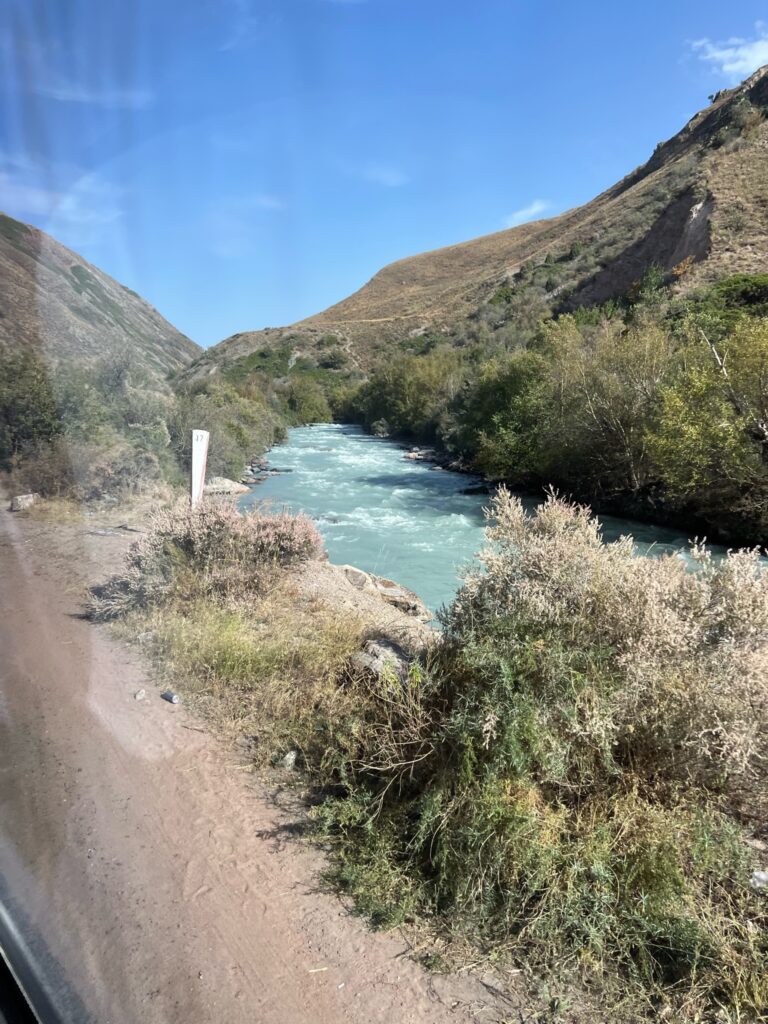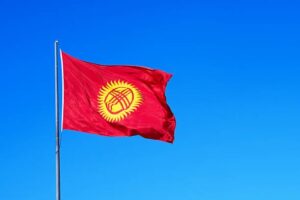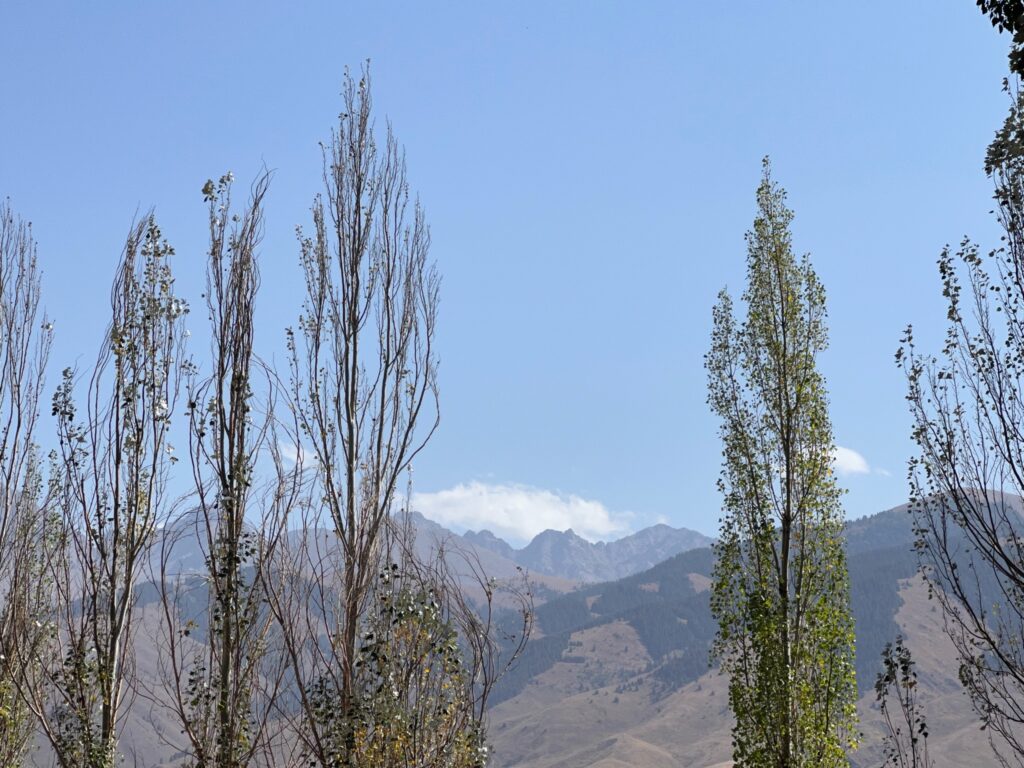16 September 2022
I am spirited off, by van, to the Kazakhstan border with neighboring Kyrgyzstan. Except for the spelling, how does the history and culture of this country differ? Kyrgyzstan flies a brighter national flag, is more rugged and mountainous, is home to 6 million Kyrgyz, does not share a border with Russia, hosts a population over three times denser over far fewer square miles and has but a small fraction of the GDP of its oil-rich neighbor Kazakhstan.

Kyrgyzstan shares much of the same influences and history as most of the stans in Central Asia. Lying along the Silk Road, Kyrgyzstan is landlocked with mountainous terrain and deep canyons which helped to geographically isolate its ancient culture. It has born witness to a variety of cultures and empires during the past 2000 years. Yet it still fell under the Russification of the USSR, achieving its independence in 1991 when it developed its own parliamentary constitution which recognized Kyrgyzstan as a secular state.
The first portion of our drive, about three hours, is along good highways, co-built with China who is always willing and eager to spread their wealth and influence. We are told the nomad’s soul is the sand and there is plenty of it, for miles as far as the eye can see to the mountain ranges. The rolling, golden hills look similar to California’s Central Valley. Unique stone carvings of animals and warriors sit atop the promontories signifying tribal lands. Muslim nomad cemeteries dot the rocky, arid landscape, wheat fields abound, it’s open range for cows and horses. Grazing horses remind me that the horse is valued here for many reasons. It is also a valued meat, more so than beef, with the best pieces going to the most important of the guests. I am told the most important cut comes from the ass-end of the horse. That may be, in a sardonic way, appropriate, especially for state dinners.
Testing the DNA of these hardy people, one will find a mix of Turkic with elements of Persian, Mongolian and Russian. The country is 82% Islam, predominately speaks Kyrgyz but uses Russian as an unofficial language. Kyrgyzstan has significant deposits of metals including gold (43% of economy) and what are known as rare-earth metals. If ever something like scandium or yttrium is used in cellphones or autos, the country will strike it rich. The government gets no high fives for a lack of corruption (though the 2005 Tulip Revolution hoped for change) and has a way to go to improve human rights, particularly for religious leaders, journalists, women, and the LGBT community. Following independence, many ethnic groups dropped in numbers as Germans, Russians, Uzbeks and Ukrainians emigrated.
The US did have an air base located in Central Asia and were asked in 2009 to pack up and leave. The president, instead, renegotiated our annual rental contract from $17 million to $60 million. Unknown who benefited the most from that deal considering Kyrgyzstan is perceived the world’s 31st most corrupt country out of 100 studied. Results show Kazakhstan as least corrupt at 38th, Uzbekistan at 26th, Tajikistan at 25th and Turkmenistan holding onto their 19th position. (No kudos for the USA which is at #67 and is slipping fast in the ranks of the least corrupt.)
Kyrgyzstan was adversely affected by the breakup of the Soviet Union. As the ninth poorest country in the USSR, it continues its struggles and over 22% of its population live in poverty, which is a huge level in comparison with those in the west; typically, when the Soviets pulled out of their republics, so did their industries and support. Plentiful water and mountainous terrain lends itself perfectly for hydroelectric power, which is a huge export.
Crossing of the Kazakhstan/Kyrgyzstan border is fairly simple. I am warned it may take 1-2 hours to pass between the two checkpoints, although this “no man’s land” is little more than 900 feet. (It takes about 30 minutes because we walk; vehicles are backed up for hours if not a day or so.) As people drag all their belongings, I appreciate my little backpack. Once through border control, a new Kyrgyz driver is waiting. We keep our guide, Ulan, as he is Kyrgyz and will stay until the Uzbek border.

The national flag gaily flaps in the breeze. “Kyrgyz” is believed to have come from the Turkic word for “forty” representing the forty clans of Manas, an epic poem and legendary hero who united these clans to fight the Uyghur invaders. The 40-ray golden sun on a red field references these forty tribes. The sun’s center depicts the crown of a yurt, commonly the nomadic home of the Kyrgyz on the steppes of Central Asia.
We continue our drive through the spectacular countryside of the Chüy Region of Chon-Kemin Valley, site of a devastating 7.7 earthquake in 1911. The long, beautiful valley meanders for miles between parallel mountain ranges and is home to mountain sheep, wild boar, golden pheasant and a host of flora. Its lakes are numerous and clear; the rivers all flow into a closed system which does not reach the sea. We follow the fast moving, turquoise Chon-Kemin River on our way to the small village of Kolmakov Aashu. Surrounded by mountains, Kyrgyzstan is farthest from any sea than any other country. I can see why it is often referred to as “the Switzerland of Central Asia.”

Our accommodation is not one of the valley’s yurt encampments, but the Ashu Guest House. We check out our modest room, good wifi, availability of alcohol, then leave for a walkabout. The village is small, children friendly, chickens and cows are out as is school. The young man age 7-8 with his suit and bow tie is quite charming. I’m sure people wondered what all the photo taking was about. Nothing special to them but quite picturesque and charming after the big city of Almaty. It is a quiet, simple village life.
Our rooms are comfortable, the food tasty. We are sleeping tonight under a clear sky amid real peace and solitude and about as far away from the troubles of the world as one can get and still have good wifi.
0 Comments